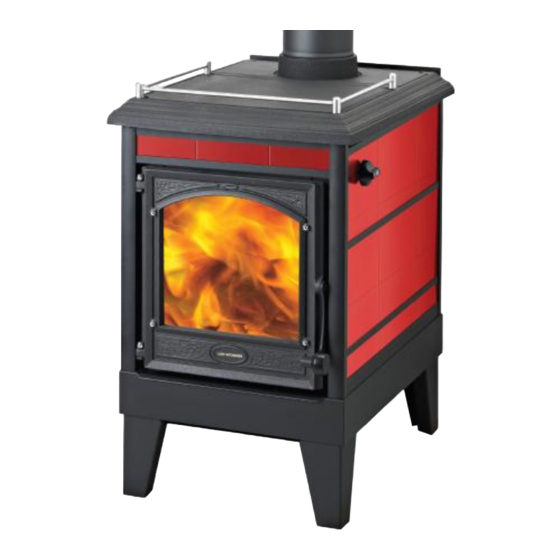Firenzo Lady Kitchener Instrukcje użytkownika - Strona 7
Przeglądaj online lub pobierz pdf Instrukcje użytkownika dla Piec na drewno Firenzo Lady Kitchener. Firenzo Lady Kitchener 9 stron. Freestanding woodburner
Również dla Firenzo Lady Kitchener: Podręcznik (10 strony), Instrukcja instalacji (8 strony)

7
8. HETAS requirements
8.1 More detailed advice about existing chimney usage
NOTE: A chimney height of not less than 4.5 metres measured vertically from the outlet of the stove to the top of
the chimney should be satisfactory. Alternatively the calculation procedure given in EN 13384-1 may be used as
the basis for deciding whether a particular chimney design will provide sufficient draught.
The outlet from the chimney should be above the roof of the building in accordance with the provisions of Building
Regulations Approved Document J.
If installation is into an existing chimney then it must be sound and have no cracks or other faults which might
allow fumes into the house. Older properties, especially, may have chimney faults or the cross section may be too
large i.e. more than 230 mm x 230 mm. Remedial action should be taken, if required, seeking expert advice, if
necessary. If it is found necessary to line the chimney then a flue liner suitable for solid fuel must be used in
accordance with Building Regulations Approved Document J.
Any existing chimney must be clear of obstruction and have been swept clean immediately before installation of
the stove. If the stove is fitted in place of an open fire then the chimney should be swept one month after
installation to clear any soot falls which may have occurred due to the difference in combustion between the stove
and the open fire.
If there is no existing chimney then any new system must be to the designation described above and in
accordance with Building Regulations Approved Document J.
A single wall metal fluepipe is suitable for connecting the stove to the chimney but is not suitable for use as the
complete chimney. The chimney and connecting fluepipe must have a minimum diameter of 150 mm and its
dimension should be not less than the size of the outlet socket of the stove.
Any bend in the chimney or connecting fluepipe should not exceed 45°. 90° bends should not be used.
Combustible material should not be located where the heat dissipating through the walls of fireplaces or flues
could ignite it. Therefore when installing the stove in the presence of combustible materials due account must be
taken of the guidance on the separation of combustible material given in Building Regulations Approved
Document J and also in these stove instructions.
If it is found that there is excessive draught in the chimney then a draught stabiliser should be fitted. Fitting of a
draught stabiliser will affect the requirement for the permanent air supply into the room in which the stove is fitted
in accordance with Approved Document J (see also combustion air supply).
8.2 Commissioning and handover
On completion of the installation and commissioning ensure that the operating instructions for the stove are left
with you, the home owner or stove user, by the installer. Ensure you are advised on the correct use of the
appliance and that you understand to use only the recommended fuel for the stove.
8.3 Warning note on fume emission
Properly installed, operated and maintained this stove will not emit fumes into the dwelling.
Occasional fumes from de-ashing and re-fuelling may occur. However, persistent fume
emission is potentially dangerous and must not be tolerated. If fume emission does persist,
then the following immediate action should be taken:-
(a) Open doors and windows to ventilate the room and then leave the premises.
(b) Let the fire go out.
(c) Check for flue or chimney blockage and clean if required
(d) Do not attempt to relight the fire until the cause of the fume emission has been identified
and corrected. If necessary seek expert advice.
The most common cause of fume emission is flueway or chimney blockage. For your own
safety these must be kept clean at all times.
CU-2013-05-14
